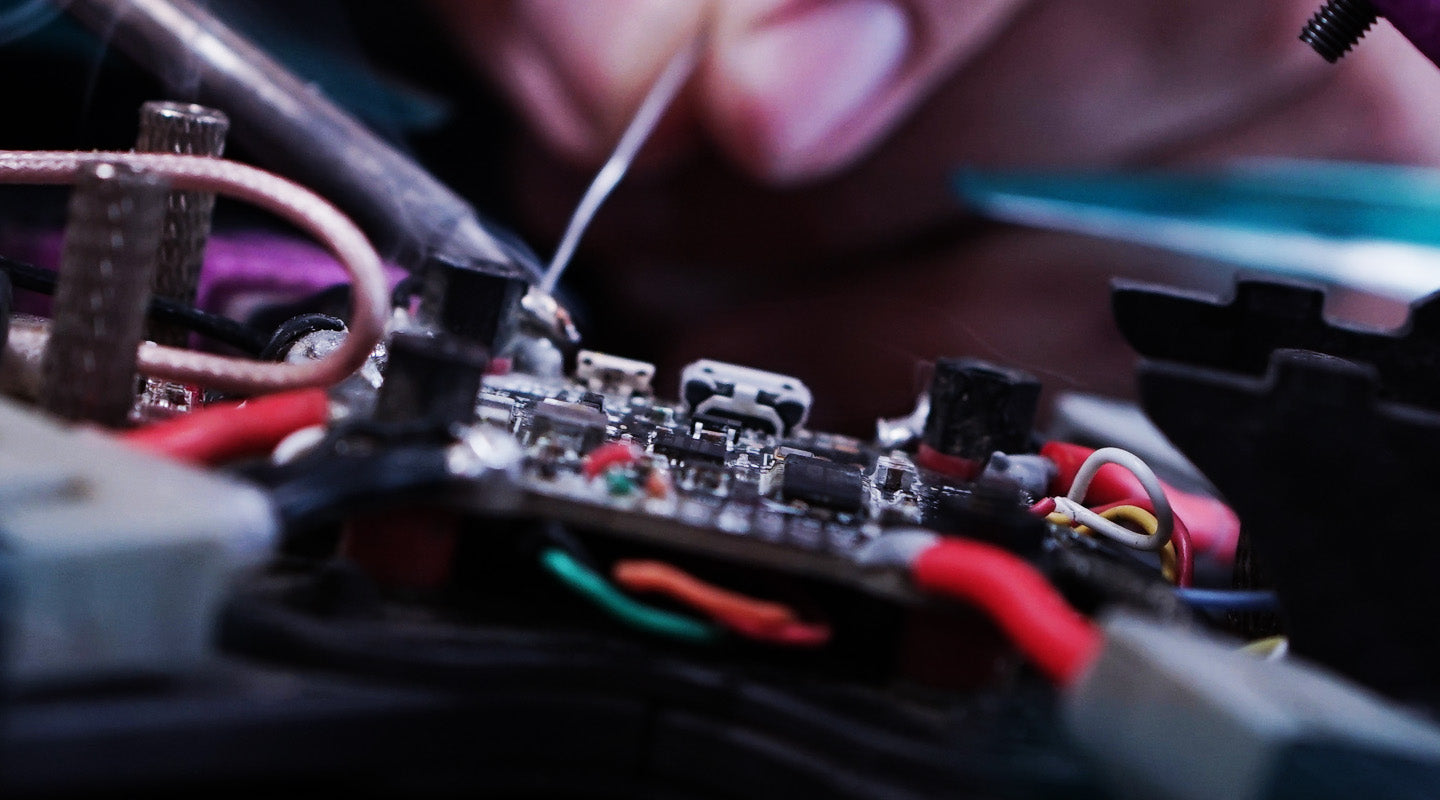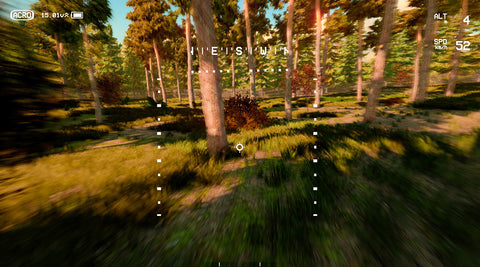What Is FPV?
What Is FPV?

FPV stands for “First Person View”.
You might have played with a Radio Control (RC) toy before, such as a toy car. Imagine that, instead of looking at the vehicle from the outside, you could be virtually “sitting” inside the vehicle? That’s FPV.
Maybe you’ve played a video game where you fly an aircraft through a virtual environment. What if, instead of flying a virtual aircraft, you could be flying a real aircraft through a real environment? That’s FPV!
But how does it work? We’ll dig deeper into this later on, but to put it simply, you put a camera on a remotely controlled vehicle, that transmits the video it captures, in real time to a display that you look at while you control the vehicle.

While you could technically install an FPV system on any remote controlled vehicle, such as a RC car, RC boat, RC airplane, and more… here at UPart, it’s all about FPV DRONES!
More About FPV Drones
The word drone has taken on many meanings over the past few decades. But today, the word drone is globally used to describe the small non-manned flying machines that rely on multiple propellers to sustain flight.
In technical terms, our FPV Drone can be categorized as multi-rotors. A multi-rotor is an aircraft that flies not by air traveling over wings, but by propellers blowing air downwards. The most common multi-rotor type is a quadcopter, which has four rotors (spinny things). There are also bicopters (2 rotors), tricopters (3 rotors), hexacopters (6 rotors), octocopters (8 rotors), and so on. Unless specified otherwise, you can assume we’re talking about a quadcopter - a drone with 4 motors.

What makes a drone so awesome is how versatile its range of movements is. By adjusting the thrust between the motors, the drone can tilt itself and move through the air in any direction. It can hover in place. It can move sideways. It can move up, and down, and forwards, and backwards.
Now this: we’re putting a camera on that drone! And the camera transmits the image to a display and then to your eyes, so you’re virtually sitting inside the drone!
So you get all that freedom of movement, the freedom of flight, opening the door to creative expression on an unprecedented level. And that’s where it starts to get exciting!
FPV Drone Freestyle
FPV Freestyle is all about expressing yourself through the movement of your drone, flowing through a landscape or structure and pulling off impressive tricks. Kind of like a skateboarder tearing up a half-pipe or a dancer moving to the music, FPV Freestyle is all about moving through an environment and framing it in a novel and entertaining way, while maybe also doing awesome, physics-defying tricks.
Cinematic FPV Drones
Cinematic FPV Drone flying is closely related to FPV Freestyle. In fact, the equipment is usually very similar. However, instead of focusing on stunts and tricks, Cinematic FPV aims to present expansive landscapes, breathtaking scenery, or fast-moving subjects in an aesthetically pleasing way. Cinematic FPV pilots aim to minimize camera movement, rather than drawing attention to it like with Freestyle.
FPV Drone Racing
Drone Racing is easy to understand. Pilots race their drones around a course, and the first one to pass the finish line wins. Drone Racing tracks are usually built using “gates”, which are rectangular or circular obstacles that the pilots must pass through, as well as “flags”, which are vertical obstacles that the pilot must pass between or to one side of.
Drone Racing usually appeals to people who are highly competitive, and who like going fast. It’s not uncommon for drone racers to have enjoyed other forms of racing previously, such as motorcycle or kart racing. Drone Racing is cheaper and physically safer than other racing disciplines, while being just as exciting!
Parts of an FPV Drone System

An FPV Drone System consists of several different parts, but we’ll break them down in a way that’s easy to understand. (There’s a variety of specialized components and accessories that we won’t go over in this basic guide.)
The Parts that FlyThe Frame
The Flight System
The FPV System
The FPV Goggles
The Remote
The Gear, Equipment & Tools
The Frame

This part is easy. The frame is just the structure that holds everything together. They’re typically made from carbon fiber, combined with metal or plastic parts. The FPV frame needs to be durable, so that the quad can withstand damage caused by crashes (because those tend to happen a lot). The FPV frame also needs to be easy to work with, giving easy access to electronics to make repairs quick and easy.
Here are some examples of FPV Frames.
The Flight System

The Flight System includes everything required to give the drone the ability to fly. The components that make up this system are the battery, propellers, motors, the motor controllers (ESCs), the receiver, and the flight controller.
Battery
Propellers
Motors
ESC’s
Receiver
Flight Controller
The Battery

The Battery is obviously essential. It provides power to all our airborne systems. Since weight is a concern, and our favorite drones require an absurd amount of power be delivered in short bursts, our options for batteries are essentially limited to rechargeable Lithium Polymer batteries or LiPo’s.
Here you can see a few different FPV Drone Batteries.
The Propellers

Propellers work just like fan blades. We like to call them “props” for short. They blow air in one direction, producing a force in the opposite direction. There are different sizes and shapes of props, and which one you use depends on the size of drone and the “flight feel” you are looking for.
Spinning propellers are the most dangerous parts of a drone.
Check out the large variety of high performance propellers.
The Motors

The Motors are what make the propellers spin. The high performance motors we use are called “brushless motors”, and they can spin at speeds up to tens of thousands of revolutions per minute. The motors require very accurate control to work properly, so a device called ESC is used to control the power going to it.
Hypetrain Motors make premium FPV Motors.
The ESCs
The ESC - which stands for Electronic Speed Controller, is the part that gives the motors the ability to run smoothly and reliably at a wide range of different speeds. Each motor needs it’s own individual ESC. Recently, the trend is to put 4 ESC’s on a single device. These are called 4-in-1 ESC’s.
Here are some examples of 4 in 1 and single ESC's.
The Receiver
The Receiver is simple. It uses it’s antenna to receive the pilot’s commands, and sends them to the Flight Controller.
The receiver needs to match the brand of the controller.
The Flight Controller

The Flight Controller, or “FC” for short, is the central connecting part of a drone. You can think of it as the “brain” of the drone, as it is able to communicate with every other device on the drone. It processes the commands from the pilot, and translates that into separate instructions to each motor. It also has a sensor called a gyroscope, which helps it retain its orientation and corrects for turbulence, wind, drifting, and other external factors.
Some FC’s are also able to process video signals. This lets them overlay visual information on the live video that’s being streamed to the pilot, such as battery voltage, signal strength, and more.
There are many flight controller options available, each with different features.
The FPV System
The components we’ve discussed will allow stable flight. But the most fun you can have with a drone, the real magic of the FPV Experience, lies in the FPV system. Currently, there are 2 types of FPV systems, Digital and Analog FPV Systems. While there are big differences between the two system, we will instead focus on the similarities here. Even the most basic FPV system usually boils down to these components:
The FPV Camera
The Video Transmitter
The FPV Camera

The FPV Camera is a small camera that sits at the front of the drone. It captures video in real time and sends it to the Video Transmitter. The FPV Camera is usually not capable of recording high quality video. So it’s common to see lightweight HD cameras, such as GoPro cameras, mounted to FPV drones.
FPV Cameras bought by themselves are usually analog.
The Video Transmitter
The Video Transmitter converts the video signals from the camera into wireless signals. The Video transmitter has an antenna that transmits these wireless signals to the pilot’s FPV Goggles.
A high quality Video Transmitter is recommended for the best experience.
The Ground Equipment
The Remote

The Remote is what the pilot uses to give commands to the drone. The drone’s remote usually has two control sticks, which offer precise piloting control, and a few switches or buttons that can be configured to perform certain functions on the drone.
Try to get a controller that fits in your hands comfortably.
The FPV Goggles

The Goggles are probably the most important part of a great FPV Experience. They have an antenna that receives the wireless video signals from the drone and a video screen that displays the video feed that’s streamed from the FPV camera.
There are other devices that are able to receive and display the FPV video feed, such as small monitors, but since goggles are mounted close to your face and block the visibility of your surroundings, they provide an unmatched level of immersion.
There's a wide range of goggles for every budget.
The Gear, Equipment & Tools

The stuff we’ve gone over is all you need to fly, but before you can head out to fly again, you’ll need a good Charger that’s capable of recharging your LiPo batteries. There are many ways to go about charging batteries, but we won’t go deep into that in this article.
When it comes to building or repairing your drone, you’ll need some basic tools. Here are the essentials:
Quality Hex Drivers are required to assemble most frames. The most common sizes are 1.5mm, 2mm, and 2.5mm.
A good soldering iron, along with some solder and flux, will allow you to connect certain components that do not use plug-in connectors, such as the motors.
A propeller tool will let you install, replace, or remove propellers. For most standard-sized FPV drones, this would be a M8 nut driver.
That covers the essentials, but there are many tools, gear and accessories that can improve your experience. A good example is a bag or backpack to carry your gear safely - not essential, but definitely practical!

How do I get into FPV Drones?
So you’ve learned a thing or twenty about FPV Drones, and now you want to get your own. But where should you start?
Start with a FPV Drone Simulator!

If we could only make one recommendation for your journey into FPV Drones, it would be this. A FPV simulator is a computer game or phone app that allows you to try FPV virtually before investing in brand new FPV equipment. In the simulator you can practice for hours, trying new moves, learning new skills, and crash hundreds of times without having to buy a single replacement part! It’s a good idea to fly at least 5 hours in the simulator before going for the real thing. You’ll thank us later!
We recommend getting a drone controller that you can use with the simulator, because this way you’ll be able to train your fingers’ muscle memory - making the transition to real FPV flight smooth and easy!
Let us help you get into FPV
We love FPV Drones, and we’d love to help you get into FPV Drones too! Our professional support staff is is ready to help you set up your own FPV Experience! Click the orange chat button to send us an email.
